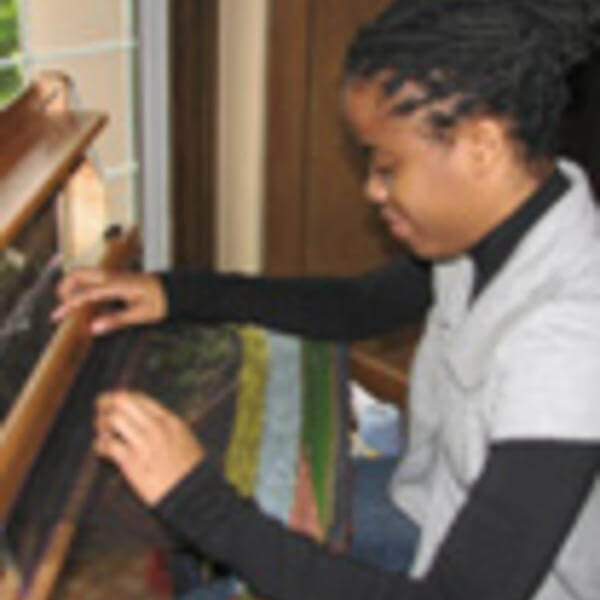Every Tuesday afternoon, a group of students from the College of the Holy Cross heads off campus to the Worcester Boys and Girls Club, where they spend time with local children doing a range of activities, from helping with homework to performing hip-hop dance routines, to sharing an after-school snack made on the Club’s George Foreman grill.
It’s a tradition that’s been going on for years through the College’s Student Programs for Urban Development (S.P.U.D.) program, but last September Holy Cross students helped introduce a new activity that’s become extremely popular – Saori, a traditional form of Japanese weaving.
Saori is a soothing and relaxing weaving technique that emphasizes the uniqueness of each woven piece and its relation to the individual weaver. There is no pattern for Saori weaving and there are no mistakes.
Working with Joan Kariko, from Saori Worcester, a weaving studio just miles from campus, Holy Cross students provide instruction, assist the boys and girls with their weaving projects, and encourage their creativity. Kariko brings several different looms to the Club and children sign up to use the looms in different time slots. There is one large loom where the children take turns weaving a large tapestry for the Boys and Girls Club, and there are also smaller looms where children can start and finish their own projects. The weaving program is evolving as Kariko is introducing weaving designs that relate to the students’ heritages.
Julia Czaplinski ’12, student director of the Boys and Girls Club program, describes her experiences with Saori as enjoyable and valuable. “We try to help the children with their weaving if we can, but they usually know more than we do,” she said. “It's very rewarding to be able to work with both the Boys and Girls Club in Worcester and with a fellow Worcester community volunteer on a project that is helping at-risk youth. At the loom, the boys and girls are transformed into weavers and artists and can leave their societal differences behind.”
The children at the Boys and Girls Club are not the only ones who have discovered the benefits of Saori weaving. Mary Beth Kearns- Barrett ‘84, director of service and social justice programs, in the Holy Cross Chaplains’ Office, has started integrating Saori into spiritual retreats for students and has encouraged students to bring the looms to Abby’s House, a shelter for battered women and their children. “The weaving is used as a healing exercise that quiets the mind as the artist focuses on his weaving,” she said. “It dispels the need for perfection and allows people to be at peace with themselves and their own unique qualities.”
Elizabeth Green ’10, who helped introduce Saori to the women at Abby’s House, agrees. “During my first Saori tutorial I was in awe at how peaceful and freeing working on the loom was. As a senior, consumed by worry about applications, graduate schools, and future plans, I fell in love with the tranquility and freedom I felt while weaving,” she said. “Weaving has also helped strengthen my relationships with the women at Abby’s House. Before Saori, I was just a volunteer and felt a little like an outsider, but thanks in large part to the loom, I now feel like real friendships are forming between me and the women.”
“What I love about the weaving is that it provides people – children at the Boys and Girls Club, women at Abby’s House and Holy Cross students – with an opportunity to slow down,” said Kearns-Barrett. “It encourages us to be creative, spontaneous, and contemplative. These are such important aspects of being human and key values in Ignatian spirituality, yet our day to day over scheduled lives don't often provide such opportunities.”
By Claire Moynahan '10
Students Weave a Bond Between Holy Cross and the Worcester Community

Saori Weaving is popular addition to student life and community service
Read Time
3 Minutes